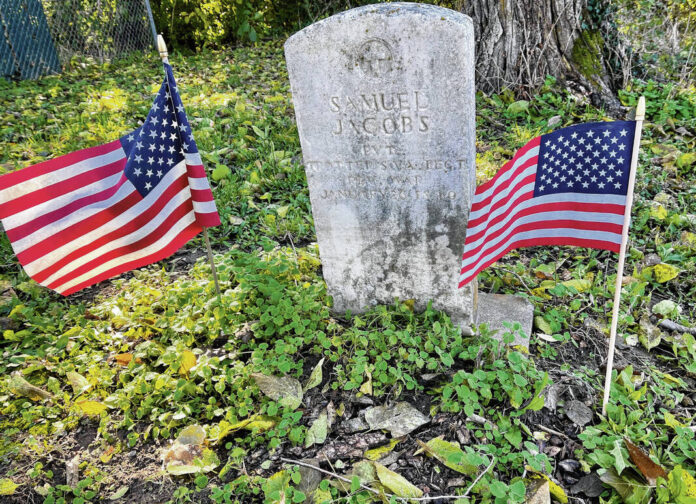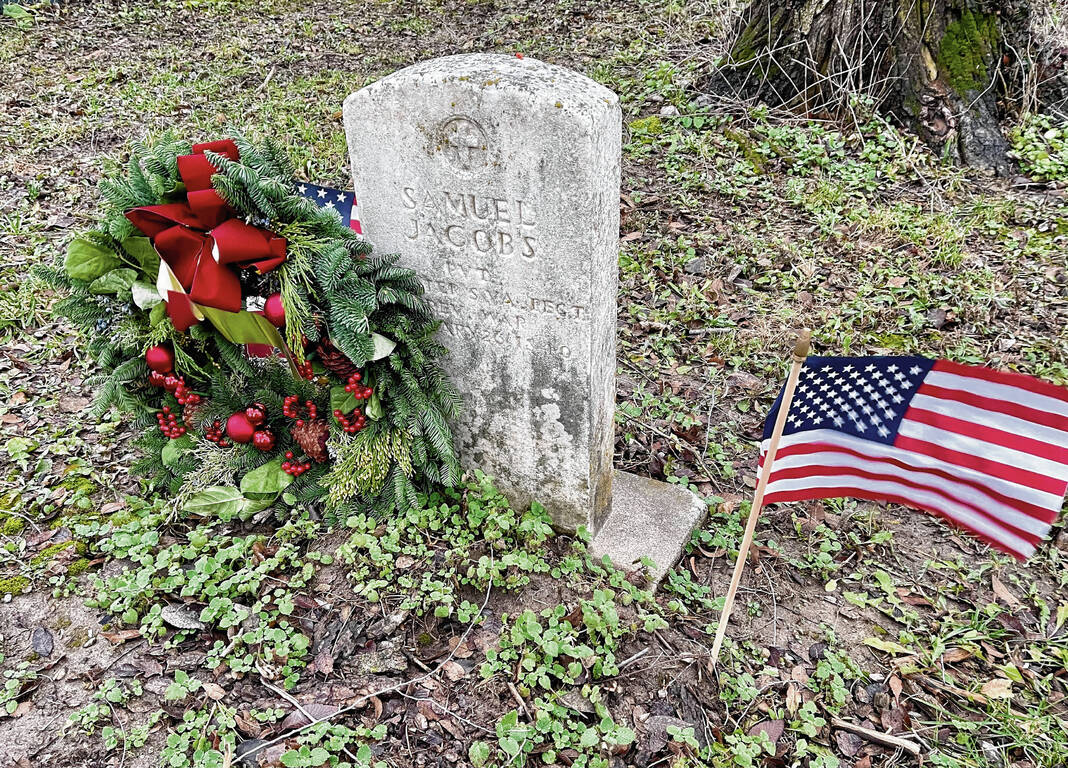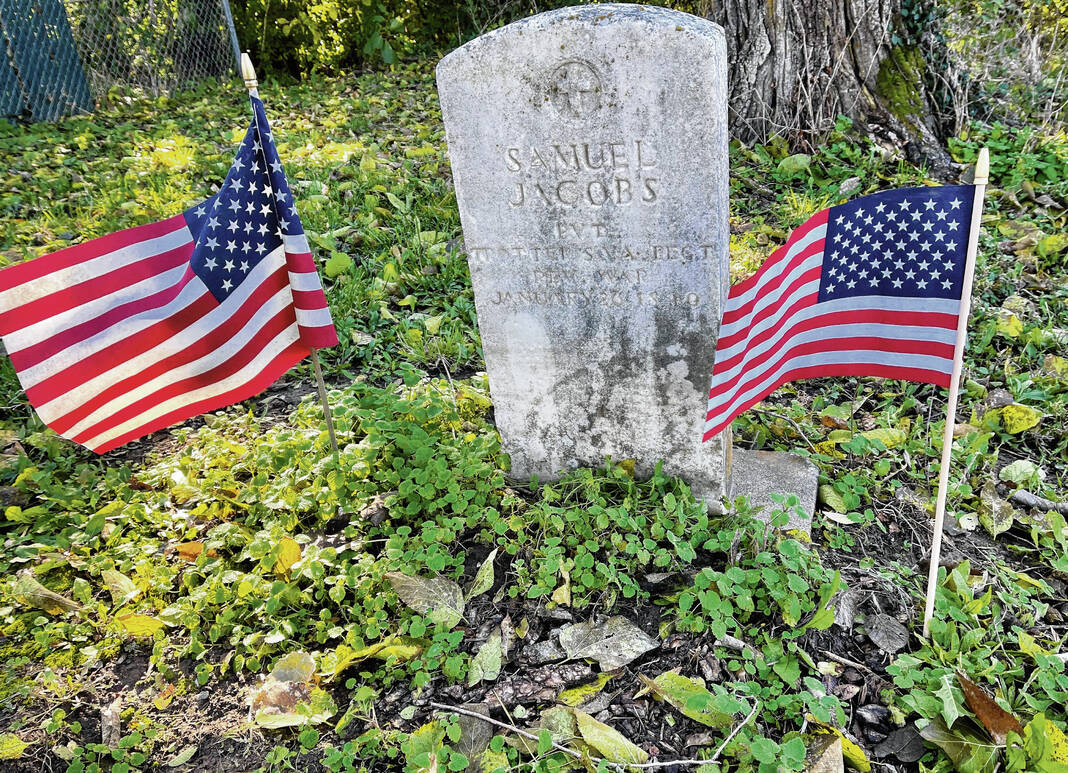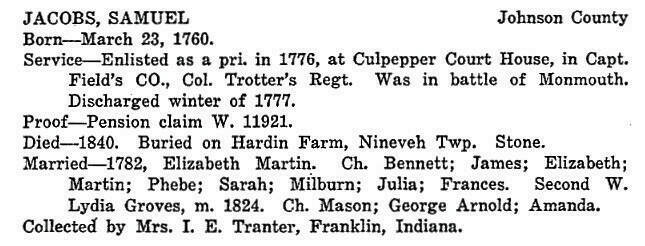On the outskirts of Nineveh, a Revolutionary War veteran has his final resting place.
The nondescript gray headstone stands alone underneath a towering tree, situated among the fencing and vegetation of a residential backyard.
For years, the significance and story of Samuel Jacobs’ gravesite had been lost to history. Only recently, through the efforts of his fifth great-grandson, has it been rediscovered and properly honored.
“It really pulls something together,” said Bob Jacobs, who researched and located his fifth great-grandfather’s grave. “I don’t think you can understand where you’re going if you don’t understand the history of where you’ve been.”
Through tireless research and the help of other historians and genealogists around the area, Bob Jacobs has been able to locate the grave of his ancestor. Samuel Jacobs is buried in a Nineveh backyard, his simple headstone situated underneath a tree.
The Revolutionary War veteran, who also served in the Frontier Wars of the 1790s and the War of 1812, is being honored by the Indiana Society of the Sons of the American Revolution during a private gravesite marking in April.
“The (Sons of the American Revolution) has three goals that they go for: education, patriotism and history. These kind of ceremonies tick all of those boxes. It’s a way to reach out to the public and say, hey, there are 2,000 patriots buried in Indiana,” said Jacob Vink, vice president of the Indiana Society of the Sons of the American Revolution. “We do the ceremonies to honor and recognize that service even if it was 245 years after he performed it.”
Jacobs started the journey to find his ancestor’s burial spot years ago. He has been active in genealogy and tracking his ancestry for more than 10 years, expanding his family tree back generations, eventually going back to the Jacobs arrival in America in 1665.
While tracing the lineage, he realized one of his ancestors, Samuel Jacobs, had fought in the Revolutionary War.
“I thought that was pretty cool, so I started tracing that and working to prove that lineage,” he said. “I spent about five years proving that I am the fifth-great-grandson of Samuel Jacobs. And then I really wanted to find out where he is.”
Samuel Jacobs was born March 23, 1760, in Hampshire County, Virginia, and when he was 16 years old, he enlisted as a private in the 2nd Virginia State Regiment. The regiment helped reinforce George Washington’s Continental Army following the heavy losses in the battles of Brandywine and Germantown.
Jacobs was also part of fighting in the Battle of Monmouth and other small battles and skirmishes, according to his pension records. He served for a term of three years, from 1776 to 1779, though he continued to be active with the Virginia militia. Family legend has it he was in Yorktown on Oct. 19, 1781, when British Gen. Cornwallis surrendered his army to Washington.
In the mid-1780s, Jacobs and his family relocated 500 miles westward to Shelbyville, Kentucky County, Virginia. He would go on to fight in the Frontier Wars with the Kentucky militia. At the age of 52, he fought in the War of 1812 as well.
In 1820, the Jacobs family moved to Washington County, Indiana, where his wife, Elizabeth, died. Samuel Jacobs ended up moving to Johnson County in 1833, remarrying and having four additional children. He died in 1840 in Nineveh Township.
Bob Jacobs had visited the graves of ancestors in Virginia from the 17th century, and thought it would be interesting to find Samuel’s burial site.
But he couldn’t find it.
According to the website FindAGrave.com, Samuel Jacobs had been buried in Nineveh Township, in a plot known as Hardin Cemetery. A photo of the headstone accompanied the entry. Bob Jacobs couldn’t find where that cemetery was located, though.
“The location they gave for it said it was off of this road, and turn here. I’m out in Texas, so I’m using Google Maps satellite, but I couldn’t see anything. There were no cemeteries there, but it showed the stone, so it had to exist,” he said.
Searching for help, Bob Jacobs reached out to a chapter of the Indiana Sons of the American Revolution. The non-profit, non-partisan organization is dedicated to promoting patriotism, preserving American history and teaching American history to future generations.
The group connected him to a member who had taken the photograph of Samuel Jacobs’ headstone in 2004, and he provided some recollections. They narrowed it down to three possible locations.
“I’m sending him PowerPoint presentations that had aerial shots of the homes, street-side views — ‘Is it this one? Is it this one?’” Bob Jacobs said. “I had pulled Google satellite images from 2005 so it looked as close as possible to when he was there.”
The next piece of the puzzle fell into place with the help of the Nineveh Township trustee’s office, who was able to search out the locations and find the stone — in the backyard of a private residence.
Volunteers from the Johnson County Museum of History and its genealogy library helped Jacobs piece together more of the story and learn why he was buried where he was.
“It’s a long story of detective work,” he said. “There are a lot of hypotheses as to why after his first wife passed away, why did he get married here, why is he buried here.”
For nearly a decade, Samuel’s grave was marked by a simple stone until it was rediscovered through a statewide initiative of the Indiana Daughters of the American Revolution and subsequently marked by a military headstone in 1938.
Bob Jacobs was able to find the owners of the home, and on Veterans Day in 2021, he mailed a package to the residence containing a Sons of the American Revolution certificate of appreciation, a stack of flags and a copy of Samuel Jacobs’ biography.
“The cover letter to the bio said that evidence led me to believe that my fifth-great-grandfather may be buried in your backyard. If not, please enjoy the flags,” he said.
The homeowner ended up calling Jacobs, and they discussed their connection. In subsequent years, Jacobs has stayed in contact, continuing to mail wreaths and flags to adorn the headstone.
He brought up the possibility of the Sons of the American Revolution holding a ceremony at the site, now known as “Jacobs Cemetery,” and the homeowners were enthusiastic about it.
The Sons of the American Revolution does about a half-dozen of the ceremonies each year in Indiana, featuring presentations by descendants of the Revolutionary War veteran, a color guard, musket salutes and laying of wreaths.
“This is the opportunity to recognize the service of this patriot, at a gravesite that would be overlooked by almost everybody but the property owners,” Vink said.
Bob Jacobs is excited to see this chapter of his family history completed, and glad to see his ancestor get the proper honor he is deserved.
And in his efforts to preserve family history, another piece has fallen into place.
“I have a history hallway in the house my wife and I live in, and if you walk through this hallway, I have photographs of eight generations of my family. Any time family come over, I want them to walk down that hallway because I want everybody to know who everyone is,” he said.










